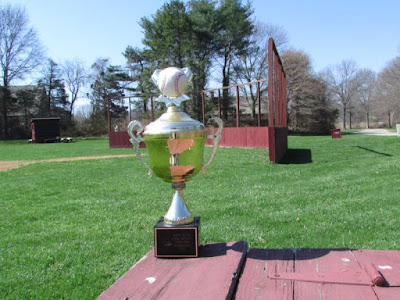William Cauldwell
The first game was a rematch with the Rising Sun Club of Maryland which defeated the Neshanock at the Old Bethpage Village Old Tyme Base Ball Festival back in August. Although it took a come from behind effort to do it, this time Flemington prevailed 12-10 before losing the second match of the day, 9-6 to the Mid Atlantic Picked 9, apparently a mixture of players from the Diamond State Club of Delaware and the Brandywine Club of Pennsylvania. The day's results left Flemington again one game above .500 with two to play, a repeat of the end of the 2013 season. The 2015 season finale was held in Kennett Square, Pennsylvania taking on first the home club and then the Ellicott City Surveyors. The only information I have is the scores, but after losing a close 7-6 contest to Kennett, as in 2013, the Neshanock came through in the second game, prevailing by a 20-16 count for the second winning season in the past three years.
A successful defense of the New York - New Jersey Cup - a 2015 highlight
2015 marked my eighth year of participation in vintage base ball, two with the Eureka Club of Newark and the last six years with the Neshanock. While I missed more games this year than usual, the experience was once again rewarding at several different levels. As I've noted before participating in vintage base ball and watching well over 200 games over that time span helps my understanding of base ball history. In saying that I want to be clear that in no way can this experience substitute for working with original source material. My time last week in the Giamatti Research Center at the Baseball Hall of Fame in Cooperstown, researching Charles Ebbets, reinforced that point, if it needed reinforcing. I've noted before that it appears that very little of the Brooklyn owner's correspondence survives, making it very difficult to learn about Ebbets by reading his own words. However, the Hall of Fame has the minute books of the National League owners meetings which through 1925 are actually verbatim transcripts of the meetings. Reading through the literally hundreds of pages of these transcripts provides a golden opportunity not just to "hear" Ebbets in his own words but to get a detailed picture of the other owners and the issues and concerns they faced during the Deadball Era. The transcripts will be a real asset in developing a picture of the Brooklyn owner.
Photo by Mark Granieri
Having said that, there are still things to be learned from the re-creation of 19th century base ball. I realized this once again while working on an essay for the SABR 19th century base ball committee's project on winter meetings. For the pre-professional period, the goal is to cover all of the meetings of the National Association of Base Ball Players and I'm working on the meetings from December of 1860 and 1864 where the major issue was the fly game vs. the bound game. During the late 1850's and through 1864 there was a concerted effort to eliminate the bound out, that is awarding an out for catching a fair ball on the bounce. Despite the efforts of some of the leading clubs and players, the change didn't come about until December of 1864. One of the prime advocates of the fly game was Henry Chadwick, the father of base ball himself, but he was countered by a less well known, but even earlier base ball writer, William Cauldwell of the Sunday Mercury (thanks to Richard Hershberger for pointing me in Cauldwell's direction).
Henry Chadwick
Photo by Dennis Tuttle
It's one more reason to be grateful for the opportunity to be part of the vintage base ball community and, in that regard, I want to thank all those who make it possible, beginning with Brad "Brooklyn" Shaw and all my teammates on the Flemington Neshanock. Among that group, special thanks to Mark "Gaslight" Granieri for taking pictures, putting up with my comments and swinging a big bat once he's able to find the playing field. I also want to acknowledge all of the teams who the Neshnaock played in the course of season without opponents the season would be one long grind of inter-squad games. One of the high points of any vintage season is the various tournaments and festivals and I thank the Elkton Eclipse, the Brooklyn Atlantics, the New York Mutuals and the Essex Base Ball Organization for some great times in 2015. In addition to opponents, base ball can't be played without umpires so a hearty well done to Sam "It ain't nothin' 'til I say" Bernstein for his work in that often unappreciated role. Finally, thanks to the spouses, significant others, girl friends and now children who attend the matches and support the Neshanock in so many different ways on and off the field. Huzzah to 2015, best wishes to all for the off season and looking forward another great year in 2016.





No comments:
Post a Comment